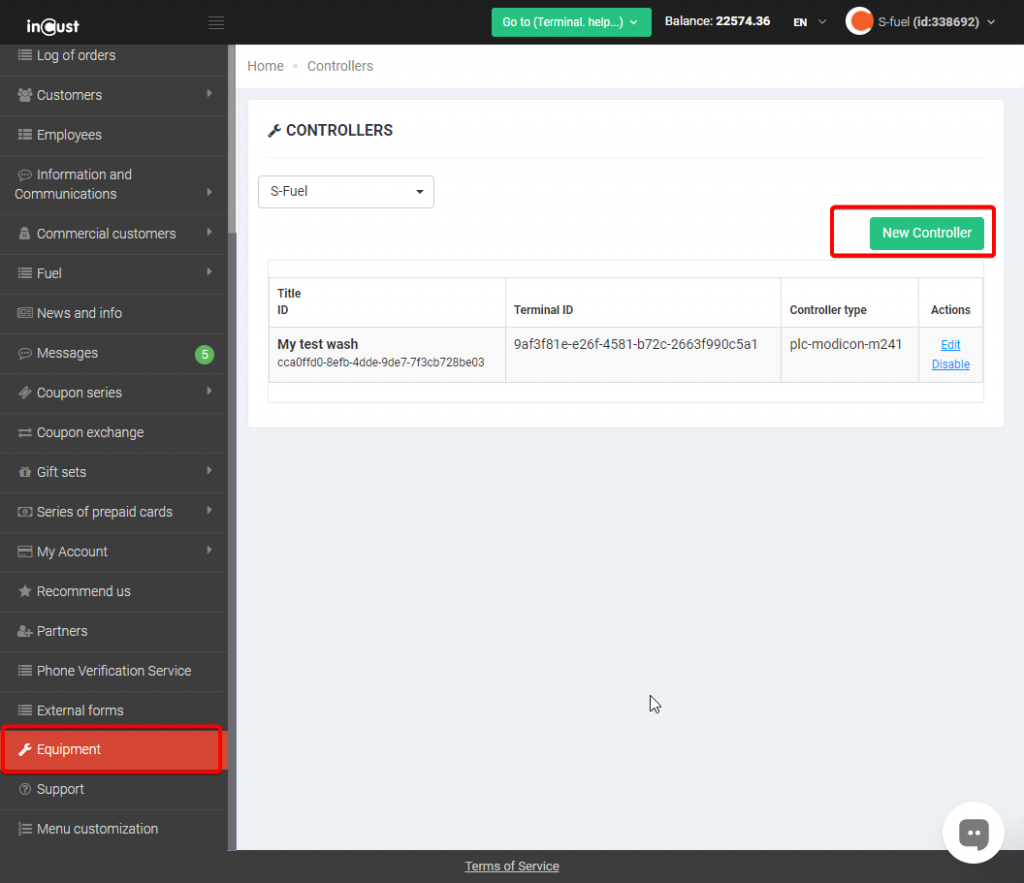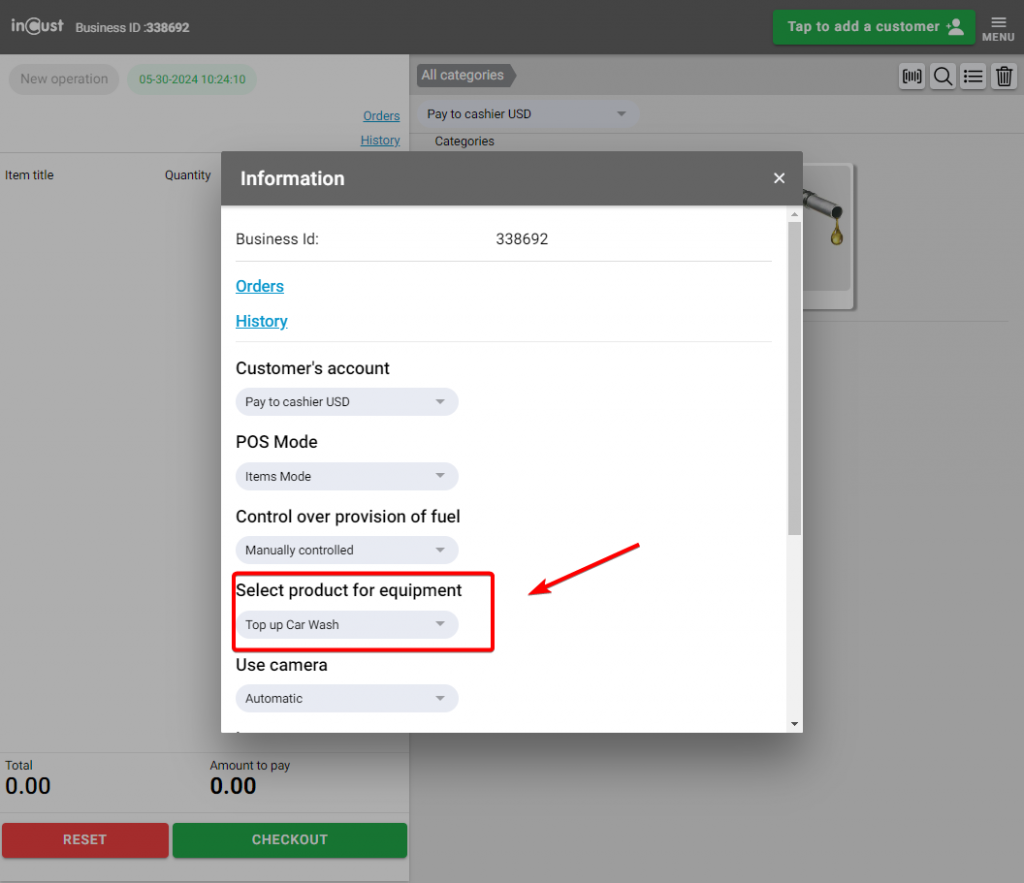Equipment, Wash Stations, or Other Vending Machines: Description of Key Features
The inCust platform helps efficiently interact with customers and now, with the help of PLC*, it can connect various devices for dispensing and payment management. The platform’s tools are perfectly suited to automate processes such as starting a wash station, vacuum cleaner, or other self-service and vending devices.
Usage Scheme:
- The user scans a QR code and goes to the payment page in the mobile app, chat-bot, or web app.
- They pay using a bank card, customer account, or commercial accounts. They can also use bonuses or coupons.
- The system sends pulses to the controller and refills the equipment’s balance.
- The customer receives their service or product by selecting it on your equipment (chooses the product code on your vending machine or selects the wash program: water, foam, vacuum, etc.).
This scheme allows you to:
- Use not only cards but also other payment methods.
- Collect a customer database and connect a loyalty program.
- Use other marketing tools to promote your services and products, such as coupons, single and multi-level referral programs.
- Gather customer feedback.
*Programmable Logic Controller (PLC) — an electronic device used for automating technological processes, such as controlling conveyor lines, pumps at water stations, CNC machines, etc.
This guide will help you start a self-service car wash business, using the inCust platform’s capabilities for efficient and automated process management.
The instructions and firmware for setting up the PLC can be found here.
1. Connecting Equipment to the Controller
Digital Input Connection
The digital input of the end equipment is connected to a specific discrete output of the PLC using a galvanic isolation relay. The PLC supports the connection of up to 100 discrete outputs. During operation, the PLC sends pulses to this output, the number of which corresponds to the transaction amount in “conditional cents”.
Monitoring Operational Status
If it is necessary to monitor the operational status of the end equipment (availability for customer transactions), the output of the end equipment (or any other “dry contact” type scheme) must be connected to a specific discrete input of the PLC. The end equipment should transmit its status to the discrete input: available – signal present, unavailable – signal absent. The PLC supports the connection of up to 100 discrete inputs.
Optional Monitoring
Monitoring the operational status of the end equipment is not mandatory but provides the advantage of informing the customer during the transaction process about the availability and readiness of the selected equipment for correct operation.
2. Mapping of PLC Discrete Outputs and Inputs
2.1 Mapping Outputs to Registers
The connection of end equipment (such as a car wash slot) is made to the discrete outputs of the PLC controller, with the possibility of connecting up to 100 outputs, for which pulse registers from 0 to 99 are reserved.
The pulse register number is uniquely identified by the number of the discrete output of the PLC controller, with an offset value of 0.
Therefore, the required number of “credits” (each “credit” is 1 pulse) is written into the pulse register corresponding to the discrete output of the PLC controller to which the end equipment is connected.
2.2 Verified (Confirmed) Record in the Register
To verify (confirm) the record in the pulse registers, their values are copied every 5 milliseconds to verification registers. Registers from 100 to 199 are reserved for verification.
Verification registers have a fixed offset relative to the write registers, equal to 100.
Any value mistakenly written into the verification registers will be overwritten by the value from the pulse register, meaning the verification registers operate in read-only mode.
2.3 Feedback from End Equipment
To check the availability and functioning of the PLC controller, a heartbeat function is used – a second-by-second increment from 1 to 1000 in a designated register.
Register number 500 is reserved for the heartbeat function.
For controlling the end equipment connected to the PLC controller, a feedback function from the end equipment is used, which is implemented by connecting the equipment to the corresponding discrete input of the PLC controller.
The end equipment transmits its status (available or not) to the discrete input.
Registers from 200 to 299 are reserved for feedback from the end equipment.
The feedback register number is uniquely identified by the number of the discrete input of the PLC controller, with an offset value of 200.
In turn, the number of the discrete input of the PLC controller to which the end equipment is connected must correspond to (equal) the number of the discrete output of the PLC controller to which the same equipment is connected.
3. Checking the Operational Status of the PLC
To verify the availability and functionality of the PLC controller, a heartbeat function is used. This involves a second-by-second increment from 1 to 1000 in register number 500.
4. Managing the PLC
In the Business Panel, there is an option to add an unlimited number of PLCs for any terminal by specifying the following parameters:
- Name (mandatory)
- IP address (mandatory)
- Port (mandatory)
- Enabled/Disabled (active) (mandatory)
- For each PLC, after it has been added and enabled, the following parameters become available:
- PLC operational status: connected and available, not connected and unavailable
- Date and time of the last connection attempt to the PLC
- Date and time of the last successful connection to the PLC
5. Managing End Equipment
In the Business Panel, for any PLC, it is possible to add up to 100 units of end equipment by specifying the following parameters:
- Name (mandatory)
- Discrete output number of the PLC (0-99) used by the equipment (mandatory)
- Ability to monitor operational status, yes/no (mandatory)
- Discrete input number of the PLC (0-99) used by the equipment to indicate operational status (mandatory only if the ability to monitor operational status is specified)
- Enabled/Disabled (active) (mandatory)
For each unit of end equipment, after it has been added and enabled, the following parameters become available:
- Unique deep-link, whose QR code should be placed next to the end equipment and will be used by the customer in the mobile application
- Operational status of the end equipment: available for customer service or not available.
After saving the entered data, a new “Equipment” tab is created for you. Add the equipment that you previously connected to the controller. To start the equipment in the inCust Terminal, you need to create a product, for example, “Top up Car Wash” Then, in the terminal settings, specify which specific product will start and replenish your equipment.




